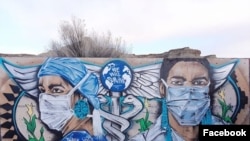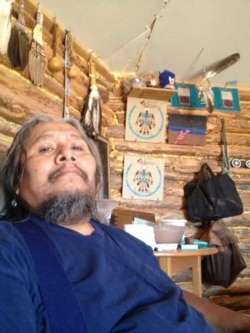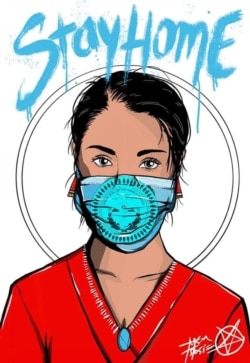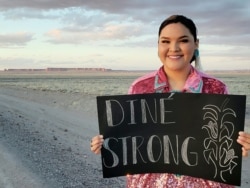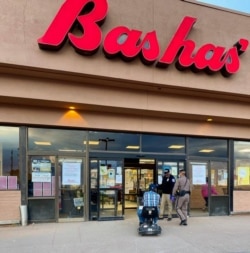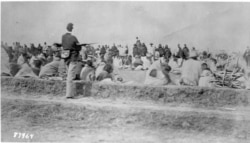Fred Willie doesn't like to call himself a healer or a medicine man -- “I’m just Fred Willie. Most people just call me ‘Uncle Fred.’”
A member of the Navajo Nation, he frequently travels to other reservations to perform healing ceremonies and hold sweat lodges. He was visiting the Chiricauhua Apache when the COVID-19 pandemic started getting serious.
“And now, the Chiricauhua don’t want me to leave,” he said. “They gave me a house here, which is really new to me. I’m used to living in a hogan [traditional Navajo house] with an artesian well; my electricity is the sun.”
Willie isn’t sure when he’ll be able to travel again and worries for his friends and family back home.
Most Navajo, he said, trace the origin of the outbreak to the tiny community of Chilchinbeto, Arizona, where on March 7, the Nazarene Church held a religious revival meeting.
“Everybody heard about this great preacher, so they came from all over,” said Willie. “And that minister was out there sweating and coughing on everybody, laying on hands. That was the beginning of the downfall.”
The first two cases were diagnosed on March 17. By the end of the first week, nearly 50 people had tested positive.
As of Friday morning, 241 Navajo have been diagnosed with the virus, and eight have died -- among them, a former U.S. Army paratrooper who leaves behind a devastated family.
Government, community efforts
Early on, Navajo health authorities closed off Chilchinbeto for quarantine. Navajo President Jonathan Nez imposed an emergency “stay at home” order March 13, shutting down schools and government offices, save for essential personnel. He released $4 million to the Navajo Department of Health to fight the spread of the virus.
This week, Nez implemented an 8 p.m. to 5 a.m. curfew, which Navajo police are working overtime to enforce.
Meanwhile, citizens are working to pass information to those who may not have access to the internet or telephone, especially the elders.
Navajo citizens like have taken to social media with song, prayers, advice and encouragement.
Keeping the elders safe is foremost on most folks’ minds.
“We have our prayers and medicines learned from our elders, that aid in our well-being,” former Miss Southwest Navajo Jaden Williams told VOA.
The first of every month is when most elders receive monthly benefits. To discourage them leaving the reservation to shop in border towns, the Navajo government instituted “Operation First of the Month,” setting up special hours for elders to shop at supermarkets on the reservation.
J.T. Willie, executive director at Navajo Nation Division of Economic Development, helped oversee that effort.
“This has been an ongoing collaborative effort with all our leadership and resources here,” he said, “but soon we will need the additional resources to help our mission.”
A plea for help
The Navajo Nation, the largest of all U.S. Indian reservations, covers 71,000 square kilometers (27,413 sq mi). Twelve Indian Health Service facilities serve as many as 350,000 citizens, but are equipped with only 170 regular beds, 13 intensive care unit beds, 52 isolation rooms and just 28 ventilators.
“The handful of emergency rooms on the Reservation are already overwhelmed with people presenting in respiratory distress,” reads a letter circulating around Facebook, attributed to public health physician Nina Mayer Ritchie.
“Many are being intubated, stabilized and flown out to tertiary care centers … but some are also dying at home or shortly after arrival to the ER and not being tested at all, because we don’t have a system in place for post-mortem testing,” Ritchie wrote. “General testing is also not widespread, so the true numbers are grossly underestimated.”
The Navajo are particularly susceptible to the virus. High rates of obesity, diabetes, hypertension and lung disease are only part of the problem.
“It’s hard to practice proper hand hygiene when there is no running water,” she wrote. “And many do not have the income to purchase soap, hand sanitizer, or even food … especially when they have to drive an hour to the closest store (if they have the money for gas) only to find that things are out of stock.”
Because multiple generations may live in a single household, entire families can be infected.
Recalling the ancestors
In a town hall meeting streamed on Facebook Tuesday, President Nez said that in spite of the passage of three COVID-19 relief bills in Washington, the tribe had not yet received any funds.
He called on citizens to help one another, citing the “Long Walk” of 1863, in which thousands of their Navajo ancestors were forced to walk several hundred miles away to the Bosque Redondo at Fort Sumner, New Mexico, where they remained for five years until signing a treaty that allowed them to return home.
“That’s when the best came out of many of our ancestors, helping each other out, carrying the load for the elders, carrying the children for our mothers, all the way there to Fort Sumner,” he said. “Now it’s our turn … to think of our future, our children, our grandchildren.”




